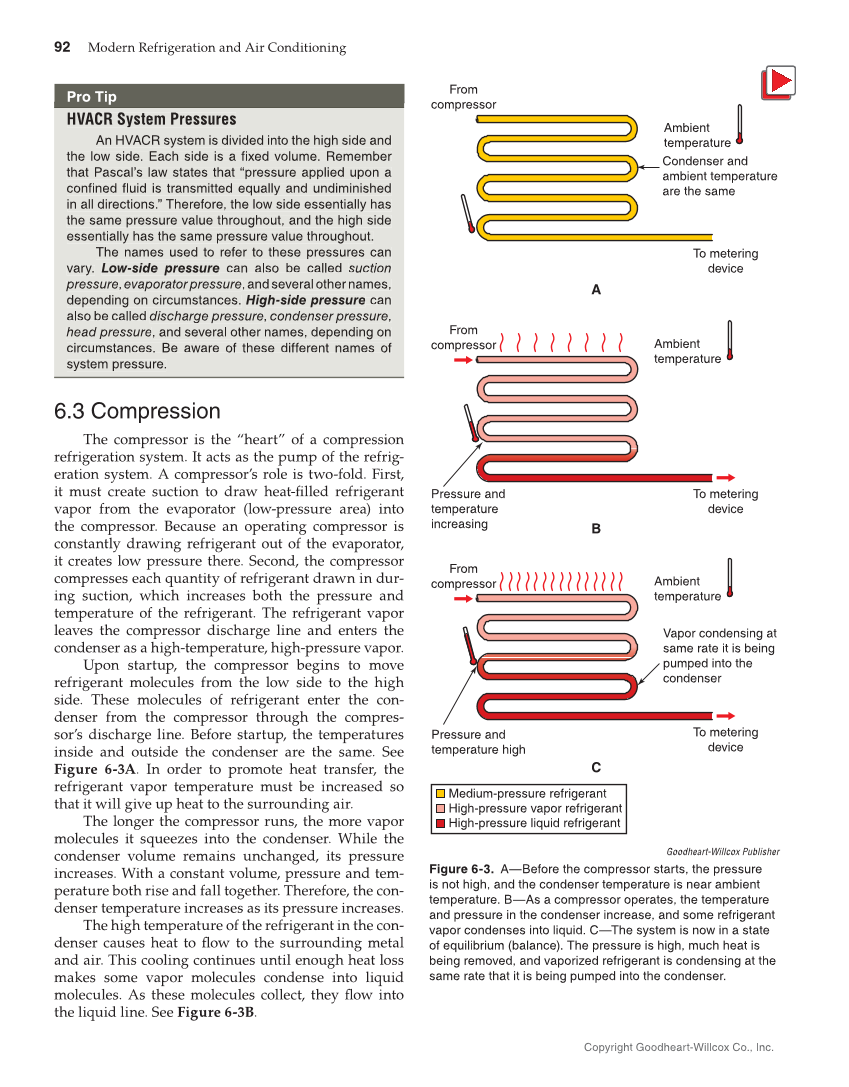92 Modern Refrigeration and Air Conditioning Copyright Goodheart-Willcox Co., Inc. Pro Tip HVACR System Pressures An HVACR system is divided into the high side and the low side. Each side is a fixed volume. Remember that Pascal’s law states that “pressure applied upon a confined fluid is transmitted equally and undiminished in all directions.” Therefore, the low side essentially has the same pressure value throughout, and the high side essentially has the same pressure value throughout. The names used to refer to these pressures can vary. Low-side pressure can also be called suction pressure,evaporatorpressure,andseveralothernames, depending on circumstances. High-side pressure can also be called discharge pressure, condenser pressure,e head pressure, and several other names, depending on circumstances. Be aware of these different names of system pressure. 6.3 Compression The compressor is the “heart” of a compression refrigeration system. It acts as the pump of the refrig- eration system. A compressor’s role is two-fold. First, it must create suction to draw heat-filled refrigerant vapor from the evaporator (low-pressure area) into the compressor. Because an operating compressor is constantly drawing refrigerant out of the evaporator, it creates low pressure there. Second, the compressor compresses each quantity of refrigerant drawn in dur- ing suction, which increases both the pressure and temperature of the refrigerant. The refrigerant vapor leaves the compressor discharge line and enters the condenser as a high-temperature, high-pressure vapor. Upon startup, the compressor begins to move refrigerant molecules from the low side to the high side. These molecules of refrigerant enter the con- denser from the compressor through the compres- sor’s discharge line. Before startup, the temperatures inside and outside the condenser are the same. See Figure 6-3A. In order to promote heat transfer, the refrigerant vapor temperature must be increased so that it will give up heat to the surrounding air. The longer the compressor runs, the more vapor molecules it squeezes into the condenser. While the condenser volume remains unchanged, its pressure increases. With a constant volume, pressure and tem- perature both rise and fall together. Therefore, the con- denser temperature increases as its pressure increases. The high temperature of the refrigerant in the con- denser causes heat to flow to the surrounding metal and air. This cooling continues until enough heat loss makes some vapor molecules condense into liquid molecules. As these molecules collect, they flow into the liquid line. See Figure 6-3B. system pressure. HVACR System Pressure s An HVACR system is divided into the high side and th e low si de . Each si de i s a fix ed volume. Remember that Pascal’s law states that “p ressure applied upon a confined fluid is transmitted equall y and undiminished in all directions.” Therefore, the low side essentially has the same pressure value throughout, and the high side essentially has the same pressure value throughout. The names used to refer to these p ressures can vary. Low-side pressure ca n also be called suction pressure , evaporator pressure , and several other names , depending on circumstances. H igh-side pressur e ca n also be called discharge pressure , c ondenser pressur , head pressure , and several other names, depending on circumstances. B e aware of th ese different names of From compressor From compressor From compressor Ambient temperature Ambient temperature Condenser and ambient temperature are the same To metering device To metering device To metering device Pressure and temperature increasing A B Vapor condensing at same rate it is being pumped into the condenser Pressure and temperature high C High-pressure vapor refrigerant High-pressure liquid refrigerant Medium-pressure refrigerant Ambient temperature Goodheart-Willcox Publisher Figure 6-3. A—Before the compressor starts, the pressure is not high, and the condenser temperature is near ambient temperature. B—As a compressor operates, the temperature and pressure in the condenser increase, and some refrigerant vapor condenses into liquid. C—The system is now in a state of equilibrium (balance). The pressure is high, much heat is being removed, and vaporized refrigerant is condensing at the same rate that it is being pumped into the condenser.
